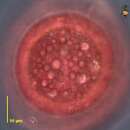en
names in breadcrumbs


Chromatium is a genus of photoautotrophic Gram-negative bacteria which are found in water.[1] The cells are straight rod-shaped or slightly curved. They belong to the purple sulfur bacteria and oxidize sulfide to produce sulfur which is deposited in intracellular granules of the cytoplasm.[2]
{{cite book}}: |author= has generic name (help) Chromatium is a genus of photoautotrophic Gram-negative bacteria which are found in water. The cells are straight rod-shaped or slightly curved. They belong to the purple sulfur bacteria and oxidize sulfide to produce sulfur which is deposited in intracellular granules of the cytoplasm.